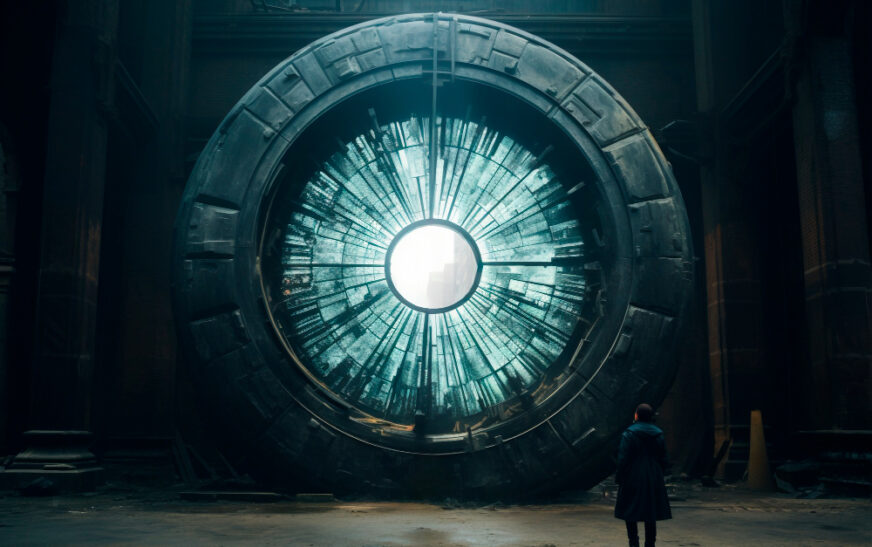Beam me up, Scotty! This iconic phrase from Star Trek has captured our imaginations for decades, igniting the dream of instantaneous travel through teleportation. While teleportation remains firmly in the realm of science fiction in 2024, the underlying physics concept – quantum tunneling – is very real and holds immense potential for future breakthroughs.
This blog delves into the fascinating world of quantum tunneling, exploring its theoretical application in teleportation technology. We’ll examine the scientific principles, the challenges involved, and the potential future implications for transportation, communication, and even medicine.
Quantum Tunneling: Unveiling the Weirdness of the Quantum World
The world of quantum mechanics operates on principles quite different from our everyday experiences. One such phenomenon is quantum tunneling, which describes the ability of a particle to seemingly pass through a barrier that, according to classical physics, it shouldn’t be able to penetrate.
Imagine a ball rolling on a flat surface encountering a wall. In the classical world, the ball would bounce off the wall. However, in the quantum world, a tiny particle like an electron could have a certain probability of appearing on the other side of the wall, even if it doesn’t have enough energy to overcome the barrier according to classical mechanics.
The Intriguing Possibility of Teleportation:
Quantum mechanics offers a theoretical framework for teleportation, the process of instantaneously transporting information or matter from one location to another. This mind-bending concept relies on the phenomenon of quantum entanglement, where two particles become linked in such a way that their fates are intertwined, regardless of the distance separating them.
Here’s a simplified explanation:
- Entanglement: Imagine two electrons (particles) being entangled. This means their quantum states are linked.
- State Measurement: The information about the quantum state of one entangled particle (let’s call it particle A) is measured.
- Instantaneous Correlation: Due to entanglement, the quantum state of the other particle (particle B) instantly changes to match particle A, regardless of the distance between them.
Theoretically, by manipulating entangled particles and controlling their quantum states, we could potentially transfer the information about the original particle (teleportation) across vast distances.
Challenges and Hurdles on the Road to Teleportation
While the concept of teleportation is captivating, there are significant challenges to overcome before it becomes a reality:
- Entanglement over Long Distances: Current technology can only achieve entanglement over very short distances. Teleporting complex objects or even humans would require maintaining entanglement over much larger scales.
- Quantum State Fidelity: The process of measuring and transmitting the quantum state of a particle is prone to errors. Achieving perfect fidelity, ensuring the receiving particle replicates the original particle’s state flawlessly, remains a significant hurdle.
- The Ethics of Teleportation: The ethical implications of teleporting living beings need careful consideration. Would the “teleported” person be a copy or the original consciousness transferred?
Quantum Tunneling Beyond Teleportation: Potential Applications in 2024 and Beyond
While teleportation of humans or large objects may still be far off, quantum tunneling has the potential to revolutionize various fields in the near future (2024 and beyond):
- Quantum Computing: Harnessing the principles of quantum mechanics, quantum computers could solve problems intractable for traditional computers, leading to breakthroughs in materials science, drug discovery, and artificial intelligence development.
- Secure Communication: Quantum cryptography utilizes entangled particles to create unbreakable communication channels, revolutionizing cybersecurity in the digital age.
- Superconductors: Understanding quantum tunneling is crucial for developing new materials with zero electrical resistance (superconductors), which could revolutionize power transmission and energy storage.
- Medical Imaging: Quantum tunneling principles may lead to advancements in medical imaging techniques like Magnetic Resonance Imaging (MRI), offering higher resolution and faster scan times.
The Road Ahead: A Quantum Leap for the Future
Quantum tunneling remains a complex and fascinating area of physics with immense potential. While teleportation of humans in 2024 might be beyond reach, the ongoing research and advancements in this field are paving the way for groundbreaking applications in various sectors. As we delve deeper into the quantum world, the possibilities seem endless.
The Ethical Considerations of Teleportation:
The possibility of teleportation raises significant ethical questions that demand careful consideration:
- The Nature of the “Teleported” Being: Would teleportation create a copy or transfer the original consciousness? This philosophical debate has profound implications.
- The Reassembly Problem: Teleporting complex objects or living beings would require reassembling them at the destination with perfect accuracy. Errors in this process could have disastrous consequences.
- Accessibility and Equity: If teleportation technology becomes a reality, who would have access to it? Ensuring equitable distribution and preventing misuse are crucial considerations.
The Need for Open Dialogue and International Collaboration:
As research in quantum tunneling progresses, open dialogue and international collaboration are essential. Scientists, ethicists, policymakers, and the public must work together to:
- Establish Ethical Guidelines: Develop ethical frameworks to guide research and development in teleportation and other quantum technologies.
- Promote International Cooperation: Encourage global collaboration to ensure responsible and ethical advancement in quantum mechanics.
- Prepare for the Societal Impact: Consider the potential social, economic, and philosophical implications of teleportation and other quantum breakthroughs.
FAQs:
- What is quantum tunneling?
Quantum tunneling is a phenomenon in quantum mechanics where a particle has a certain probability of passing through a barrier that, according to classical physics, it shouldn’t be able to penetrate. Imagine a tiny ball rolling through a wall in the quantum world – it has a chance of appearing on the other side, defying classical mechanics.
- What is teleportation?
Teleportation refers to the theoretical transfer of information or matter from one location to another instantaneously. In science fiction, teleportation often involves transporting entire people or objects. However, the scientific concept focuses on transferring quantum information.
- Can quantum tunneling be used for teleportation in 2024?
While the concept is fascinating, teleportation of complex objects or humans in 2024 is highly unlikely. Significant challenges remain, such as maintaining entanglement over long distances and achieving perfect fidelity (flawlessly replicating the original particle’s state).
- What are the potential applications of quantum tunneling besides teleportation?
Quantum tunneling has the potential to revolutionize various fields:
- Quantum Computing: Solving complex problems beyond the reach of traditional computers, leading to breakthroughs in materials science, drug discovery, and AI development.
- Secure Communication: Creating unbreakable communication channels using entangled particles for enhanced cybersecurity.
- Superconductors: Developing materials with zero electrical resistance, revolutionizing power transmission and energy storage.
- Medical Imaging: Leading to advancements in techniques like MRI, offering higher resolution and faster scan times.
- Are there ethical considerations for teleportation?
Absolutely. Teleportation raises profound questions:
- The Nature of the “Teleported” Being: Would it be a copy or the original consciousness being transferred?
- The Reassembly Problem: Reassembling complex objects or living beings at the destination perfectly is crucial to avoid disastrous consequences.
- Accessibility and Equity: Ensuring equitable access to this technology and preventing its misuse require careful consideration.
- What can we do about the ethical considerations?
Open dialogue and international collaboration are essential:
- Establish Ethical Guidelines: Develop frameworks to guide research and development in teleportation and other quantum technologies.
- Promote International Cooperation: Encourage global collaboration to ensure responsible and ethical advancements.
- Prepare for the Societal Impact: Consider the potential social, economic, and philosophical implications of teleportation and other quantum breakthroughs.
Conclusion
The world of quantum mechanics, with its mind-bending concepts like quantum tunneling, continues to push the boundaries of our understanding of the universe. While teleportation of humans in 2024 might remain firmly in the realm of science fiction, the ongoing exploration of this fascinating phenomenon holds immense promise for the future.




















